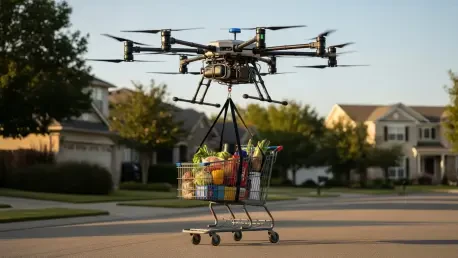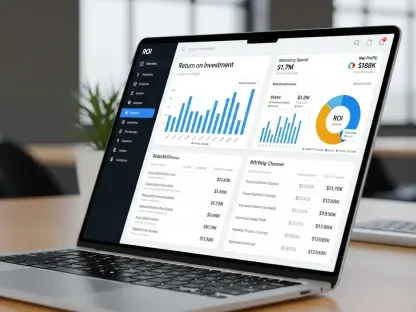Imagine a world where your urgent medication or a last-minute grocery order arrives at your doorstep in under 20 minutes, not by a delivery van stuck in traffic, but by a sleek, silent drone descending from the sky. This scenario is no longer a distant dream but a growing reality in the logistics sector. Drone delivery technology is reshaping last-mile delivery with unprecedented speed and efficiency, addressing consumer demands for instant gratification while tackling sustainability challenges. This review delves into the intricacies of this transformative innovation, exploring its technical foundations, real-world impact, and the hurdles yet to be overcome in the retail and logistics landscapes.
Core Principles and Industry Context
Drone delivery technology offers a groundbreaking approach to last-mile logistics, utilizing unmanned aerial vehicles to transport goods directly to consumers. At its heart, the system relies on autonomous flight, precise payload management, and seamless integration with retail and e-commerce platforms to ensure timely deliveries. These drones are designed to carry small to medium-sized packages, often weighing up to 5 pounds, over short distances, making them ideal for urban and suburban environments where traffic congestion hampers traditional methods.
The rise of this technology is fueled by a surge in consumer expectations for rapid delivery, spurred by the dominance of e-commerce giants and the need for cost-effective alternatives to ground transport. With environmental concerns mounting, drones also present a sustainable option, often powered by electric systems that reduce carbon footprints compared to diesel vans. Positioned at the intersection of robotics, AI, and logistics, drone delivery stands as a disruptive force, challenging conventional supply chain models and promising to redefine convenience in the modern era.
Technical Features and Performance Metrics
Autonomous Navigation and Safety Systems
A cornerstone of drone delivery is autonomous navigation, particularly the ability to operate Beyond Visual Line of Sight (BVLOS). This capability allows drones to travel long distances without direct human oversight, relying on sophisticated sensors and algorithms to map routes and avoid obstacles. Detect-and-Avoid (DAA) systems play a critical role here, ensuring safety by identifying and maneuvering around other aircraft, buildings, or unexpected hazards, a necessity for regulatory compliance and public trust.
Performance in urban settings is a key metric, where accuracy within a few feet is essential for doorstep deliveries. These systems have shown remarkable precision, often landing within designated zones despite complex environments. The ongoing refinement of BVLOS operations, supported by regulatory advancements like the FAA’s Part 108 rules finalized this year, marks a significant step toward scaling operations, though challenges remain in densely populated areas with high airspace traffic.
Energy Efficiency and Propulsion Innovations
Sustainability is a driving force behind drone delivery, with energy efficiency at the forefront of design priorities. Electric propulsion systems dominate the field, drastically cutting emissions compared to traditional delivery vehicles. Hybrid fixed-wing designs, capable of reaching speeds up to 70 mph with ranges extending to 6 miles, balance speed and endurance, catering to both urban hubs and suburban outreaches.
Innovations such as AI-driven route optimization further enhance efficiency by minimizing energy consumption through real-time adjustments to flight paths. These advancements align with corporate goals for net-zero emissions, positioning drone technology as a leader in green logistics. As battery technology progresses, extended flight times and payload capacities are expected to improve, further solidifying the environmental benefits of this approach.
Latest Developments and Market Trends
Recent strides in drone delivery reflect a dynamic interplay of technology and policy. The FAA’s implementation of BVLOS regulations has eliminated the need for individual waivers, slashing compliance costs and paving the way for broader adoption. This regulatory shift is a game-changer, enabling companies to deploy fleets at scale and expand service coverage across diverse regions.
Emerging trends also include innovative infrastructure solutions like rooftop delivery hubs in urban malls, which address space constraints and streamline operations. Additionally, AI integration for fleet management is gaining traction, optimizing delivery schedules and reducing operational expenses. Consumer behavior is shifting as well, with increasing demand for instant delivery of essentials like groceries and medical supplies, pushing companies to prioritize speed and accessibility in their strategies.
A notable market trend is the diversification of services, with drones now facilitating not just retail but also food and healthcare deliveries. Partnerships between drone operators and local businesses are on the rise, creating ecosystems that cater to niche needs. This adaptability underscores the technology’s potential to penetrate various sectors, reshaping how goods reach consumers in everyday life.
Real-World Impact and Applications
In practice, drone delivery is making waves across multiple industries, with retail giants like Walmart focusing on short-radius deliveries within 6 miles of their stores, achieving average times under 19 minutes. Such deployments cater to urgent needs, from baby essentials to over-the-counter medications, enhancing customer satisfaction in competitive markets. These initiatives highlight how drones can differentiate brands in a crowded retail space.
Beyond retail, the food service sector is embracing this technology, with companies like Alphabet’s Wing collaborating with DoorDash and Wendy’s to deliver meals in select locations. These partnerships showcase the versatility of drones in handling time-sensitive orders, ensuring hot food arrives promptly. Meanwhile, healthcare applications are proving transformative, with drones facilitating urgent medical supply drops to remote or disaster-stricken areas, bridging critical access gaps.
Unique use cases, such as white-label delivery services for smaller retailers, are also emerging, allowing businesses without in-house capabilities to offer drone delivery under their brand. This democratization of access fosters inclusivity in the market, enabling smaller players to compete with larger corporations. Collectively, these applications are redefining convenience, accessibility, and responsiveness across diverse sectors.
Adoption Challenges and Barriers
Despite its promise, drone delivery faces significant obstacles to widespread adoption, with high operational costs being a primary concern. At approximately $13.50 per delivery compared to $1.90 for ground vans, profitability remains elusive without substantial scale. Efforts to address this include automation and strategic hub-and-spoke models that extend coverage from existing infrastructure, though implementation is complex.
Regulatory hurdles also pose challenges, with zoning restrictions and public safety concerns requiring careful navigation. Urban environments, in particular, lack the necessary infrastructure for seamless integration, often necessitating innovative solutions like rooftop hubs. Public perception of drones, including privacy and noise issues, further complicates acceptance, demanding transparent communication and community engagement from operators.
Ongoing mitigation strategies involve partnerships between technology providers and retailers to share costs and expertise, alongside advancements in AI to enhance operational efficiency. While these efforts show promise, achieving a sustainable business model requires balancing investment with long-term returns. The path to mainstream adoption hinges on addressing these multifaceted barriers through collaboration and innovation.
Future Trajectory and Opportunities
Looking ahead, the future of drone delivery appears bright, with projections estimating delivery costs could drop below $3 per order by 2030 through advancements in automation and AI. Such cost reductions would make drones competitive with traditional methods, unlocking mass-market potential. Expanded BVLOS regulations are also anticipated to further ease operational constraints over the next few years, fostering growth.
Potential breakthroughs include integrating drone data into broader AI ecosystems for enhanced logistics planning, creating synergies across supply chains. This could lead to predictive delivery models, where drones preemptively position goods based on demand forecasts. As urban air mobility concepts mature, drones might also share airspace with other aerial vehicles, necessitating robust traffic management systems to ensure safety and efficiency.
The long-term impact on retail and logistics could be profound, with drones becoming a cornerstone of sustainable, on-demand delivery networks. This evolution promises not only faster service but also reduced environmental impact, aligning with global sustainability goals. The trajectory suggests a fundamental shift in how goods move, provided technological and regulatory progress continues at pace.
Final Reflections and Next Steps
Reflecting on this exploration, drone delivery technology demonstrates immense potential to revolutionize last-mile logistics with its blend of speed and sustainability. The technical advancements, from autonomous navigation to energy-efficient propulsion, showcase a robust foundation for industry disruption. Real-world applications across retail, food, and healthcare sectors further underscore its versatility and transformative impact.
Yet, the journey is not without friction, as high costs, regulatory complexities, and infrastructure gaps challenge widespread adoption. The balance between innovation and practicality remains delicate, with each stride forward met by logistical or societal hurdles. Despite these obstacles, the commitment to scalability through automation and partnerships paints a hopeful picture for stakeholders.
Moving forward, the focus should pivot to actionable strategies, such as investing in AI-driven cost reduction and advocating for streamlined urban airspace policies. Collaboration between regulators, businesses, and communities will be vital to address safety and privacy concerns, ensuring public buy-in. As the industry evolves, prioritizing pilot programs in varied environments could refine operational models, paving the way for a future where drone delivery becomes as commonplace as a mail truck, seamlessly integrated into daily life.









